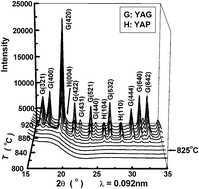Phase evolution of yttrium aluminium garnet (YAG) in a citrate–nitrate gel combustion process
Abstract

* Corresponding authors
a
Center for Thermal Spray Research, Department of Materials Science and Engineering, State University of New York, Stony Brook, NY 11794, USA
E-mail:
xiguo@ic.sunysb.edu
b Electroceramics Division, Central Glass and Ceramic Research Institute, Kolkata 700032, India
c Department of Geosciences and Chemistry Department, State University of New York, Stony Brook, NY 11794, USA
d Department of Chemistry, Brookhaven National Laboratory, Upton, NY 11973, USA

 Please wait while we load your content...
Something went wrong. Try again?
Please wait while we load your content...
Something went wrong. Try again?
X. Guo, P. S. Devi, B. G. Ravi, J. B. Parise, S. Sampath and J. C. Hanson, J. Mater. Chem., 2004, 14, 1288 DOI: 10.1039/B316434A
To request permission to reproduce material from this article, please go to the Copyright Clearance Center request page.
If you are an author contributing to an RSC publication, you do not need to request permission provided correct acknowledgement is given.
If you are the author of this article, you do not need to request permission to reproduce figures and diagrams provided correct acknowledgement is given. If you want to reproduce the whole article in a third-party publication (excluding your thesis/dissertation for which permission is not required) please go to the Copyright Clearance Center request page.
Read more about how to correctly acknowledge RSC content.
 Fetching data from CrossRef.
Fetching data from CrossRef.
This may take some time to load.
Loading related content
